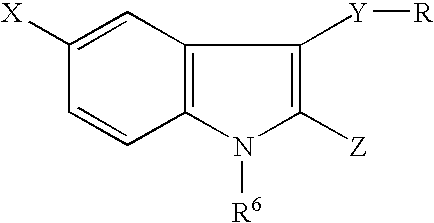Substituted phenylindoles for the treatment of HIV
- Summary
- Abstract
- Description
- Claims
- Application Information
AI Technical Summary
Benefits of technology
Problems solved by technology
Method used
Image
Examples
second embodiment
[0300]In the second embodiment of the invention, the compounds are represented generally by the Formula I defined above wherein a first series of preferred subembodiments is given when Z is defined as follows:[0301]1) Z is —C(═W)N(R1R3)C(═W)NH2; R2 is NH and R3 is alkyl;[0302]2) Z is —C(═W)—NH—CH(—C[═W]NH2)(—CH2—C[═W]—O—CH3-aryl);[0303]3) Z is —C(═W)—NH—CH2(—C[═W]NH2)(—CH2—C[═W]—O—CH3-aralkyl);[0304]4) Z is —C(═W)NHNH2;[0305]5) Z is —C(═W)NH—CH2—C(═W)NHNH2;[0306]6) Z is —C(═W)NH—CH(R2)—C(═W)NH2; R2 is NH2 or alkyl;[0307]7) Z is —C(═W)NR2—C(═W)R3; R2 is optionally substituted alkyl, alkenyl or alkynyl; and R3 is NH2;[0308]8) Z is —C(═W)NH—R2—SR where R2 is optionally substituted alkyl, alkenyl or alkynyl;[0309]9) Z is —C(═W)NH—R3—SR2 where R2 is optionally substituted alkyl, alkenyl or alkynyl and R3 is as defined in the general embodiment;[0310]10) Z is —C(═W)—NH—N(R3)(R2); R2 is hydroxyl or alkoxy; R3 is H or alkyl;[0311]11) Z is —C(═W)NH—CH2NH—CH(CH3)C(═W)OH;[0312]12) Z is —C(═W)—...
example 1
Synthesis of N-Cyclopropyl 2-[N-[5-Chloro-3-(3,5-dimethylphenylsulfonyl)-indol-2-carboxyamido]]acetamide (23)
[0457]A mixture of 2-[N-[5-chloro-3-(3,5-dimethylphenylsulfonyl)indol-2-carboxyamido]]-acetic acid ethyl ester (21), ethanol (5 mL) and cyclopropylamine (5 mL) was heated at 60° C. for 6 hours. After concentration to a small volume, the residue was extracted with ethyl acetate, washed with brine and dried. Removal of the solvent furnished a crude product which was purified by passing through a silica gel column chromatography (ethyl acetate) to give 0.14 g (69%) of title compound, mp 267-270° C. (ethanol).
N-(1-Morpholin-4-yl)-2-[N-[5-Chloro-3-(3,5-dimethylphenylsulfonyl)indol-2-carboxyamido]]-acetamide (24) was prepared using morpholine—after 48 hours. at 60° C., yield 74%, mp>300° C. (ethanol).
example 2
Synthesis of 5-(1H-Pyrrol-1-yl)-3-(3,5-dimethylphenylsulfonyl)indole-2-carboxyamide
[0458]A solution of 5-nitro-3-(3,5-dimethylphenylsulfonyl)indole-2-carboxyamide (0.25 g, 0.0007 mol) in tetrahydrofuran (40 mL) and methanol (16 mL) was reduced under an atmospheric pressure of hydrogen in the presence of PtO2 (50 mg) as a catalyst for 6 hours. Catalyst was separated by filtration and the solvent evaporated to give 0.227 g (100%) of pure 5-amino-3-(3,5-dimethylphenylsulfonyl)indole-2-carboxyamide as a brown oil. A solution of the last compound (0.227 g, 0.0007 mol), 2,5-dimethoxy-tetrahydrofuran (0.09 g, 0.0006 mol) in glacial acetic acid (5 mL) was refluxed for 30 minutes. After evaporation of the solvent the residue was triturated with ice water and extracted with ethyl acetate. Organic layer was washed with brine and dried. Removal of the solvent left the crude product which was purified by passing through a silica gel column chromatography (ethyl acetate as eluent) to give 0.15 g ...
PUM
| Property | Measurement | Unit |
|---|---|---|
| Structure | aaaaa | aaaaa |
Abstract
Description
Claims
Application Information
 Login to View More
Login to View More - R&D
- Intellectual Property
- Life Sciences
- Materials
- Tech Scout
- Unparalleled Data Quality
- Higher Quality Content
- 60% Fewer Hallucinations
Browse by: Latest US Patents, China's latest patents, Technical Efficacy Thesaurus, Application Domain, Technology Topic, Popular Technical Reports.
© 2025 PatSnap. All rights reserved.Legal|Privacy policy|Modern Slavery Act Transparency Statement|Sitemap|About US| Contact US: help@patsnap.com



